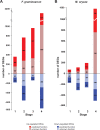Comparative Transcriptomics of Fusarium graminearum and Magnaporthe oryzae Spore Germination Leading up To Infection
- PMID: 36598191
- PMCID: PMC9973345
- DOI: 10.1128/mbio.02442-22
Comparative Transcriptomics of Fusarium graminearum and Magnaporthe oryzae Spore Germination Leading up To Infection
Abstract
For fungal plant pathogens, the germinating spore provides the first interaction with the host. Spore germlings move across the plant surface and use diverse penetration strategies for ingress into plant surfaces. Penetration strategies include pressurized melanized appressoria, which facilitate physically punching through the plant cuticle, and nonmelanized appressoria, which penetrate with the help of enzymes or cuticular damage to breach the plant surface. Two well-studied plant pathogens, Fusarium graminearum and Magnaporthe oryzae, are typical of these two modes of penetration. We applied comparative transcriptomics to Fusarium graminearum and Magnaporthe oryzae to characterize the genetic programming of the early host-pathogen interface. Four sequential stages of development following spore localization on the plant surface, from spore swelling to appressorium formation, were sampled for each species on culture medium and on barley sheaths, and transcriptomic analyses were performed. Gene expression in the prepenetration stages in both species and under both conditions was similar. In contrast, gene expression in the final stage was strongly influenced by the environment. Appressorium formation involved the greatest number of differentially expressed genes. Laser-dissection microscopy was used to perform detailed transcriptomics of initial infection points by F. graminearum. These analyses revealed new and important aspects of early fungal ingress in this species. Expression of the trichothecene genes involved in biosynthesis of deoxynivalenol by F. graminearum implies that toxisomes are not fully functional until after penetration and indicates that deoxynivalenol is not essential for penetration under our conditions. The use of comparative gene expression of divergent fungi promises to advance highly effective targets for antifungal strategies. IMPORTANCE Fusarium graminearum and Magnaporthe oryzae are two of the most important pathogens of cereal grains worldwide. Despite years of research, strong host resistance has not been identified for F. graminearum, so other methods of control are essential. The pathogen takes advantage of multiple entry points to infect the host, including breaches in the florets due to senescence of flower parts and penetration of the weakened trichome bases to breach the epidermis. In contrast, M. oryzae directly punctures leaves that it infects, and resistant cultivars have been characterized. The threat of either pathogen causing a major disease outbreak is ever present. Comparative transcriptomics demonstrated its potential to reveal novel and effective disease prevention strategies that affect the initial stages of disease. Shedding light on the basis of this diversity of infection strategies will result in development of increasingly specific control strategies.
Keywords: Fusarium graminearum; Magnaporthe oryzae; barley infection; infection process; secondary metabolites; spore germination; transcriptome.
Conflict of interest statement
The authors declare no conflict of interest.
Figures







References
-
- Chandra Nayaka S, Hosahatti R, Prakash G, Tara Satyavathi C, Sharma R. 2021. Blast disease of cereal crops: evolution and adaptation in context of climate change. Springer Nature, London, UK.
-
- Asibi AE, Chai Q, Coulter JA. 2019. Rice blast: a disease with implications for global food security. Agronomy 9:451. doi:10.3390/agronomy9080451. - DOI
-
- Pasquali M, Beyer M, Logrieco A, Audenaert K, Balmas V, Basler R, Boutigny A-L, Chrpová J, Czembor E, Gagkaeva T, González-Jaén MT, Hofgaard IS, Köycü ND, Hoffmann L, Lević J, Marin P, Miedaner T, Migheli Q, Moretti A, Müller MEH, Munaut F, Parikka P, Pallez-Barthel M, Piec J, Scauflaire J, Scherm B, Stanković S, Thrane U, Uhlig S, Vanheule A, Yli-Mattila T, Vogelgsang S. 2016. A European database of Fusarium graminearum and F. culmorum trichothecene genotypes. Front Microbiol 7:406. doi:10.3389/fmicb.2016.00406. - DOI - PMC - PubMed
Publication types
MeSH terms
Substances
Supplementary concepts
LinkOut - more resources
Full Text Sources

